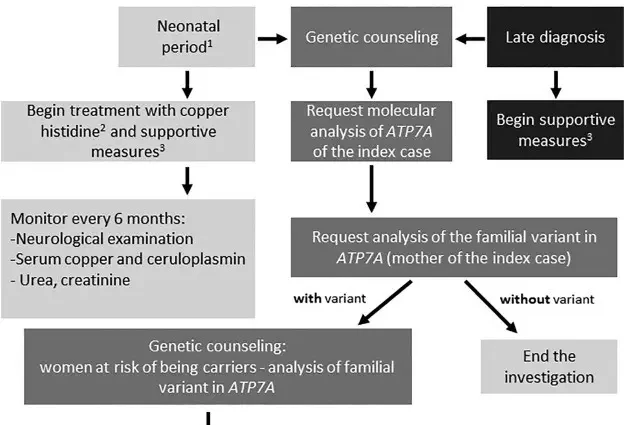It is one of the rare genetically determined disorders of copper metabolism in the body. Improper absorption and absorption of copper leads to its deficiency.
Copper deficiency in the body adversely affects its functioning. Copper is an important micronutrient that positively affects the functioning of the nervous system, blood vessels, bones and skin.
In people without genetic defects, copper deficiency in the body is very rare, although it does occur in people with celiac disease and Crohn’s disease.
Severe copper deficiency is recorded in people with a congenital malabsorption of this element. Menkes’ disease is one of these diseases. The disease is classified as a neurodegenerative disease, and its essence is the inability to metabolize copper supplied in food. The process of copper absorption should take place in the intestines, but in patients it does not.
The disease was first described by John Menkes and his colleagues in 1962. The disease was caused by a mutation in the ATP7A gene located on the long arm of the X chromosome, which encodes the copper ion binding protein. The syndrome inheritance is recessive, X-linked.
Who is sick?
It is known from the way of inheritance that they are mainly boys. Females, on the other hand, are usually asymptomatic carriers.
Medical statistics show that it is a very rare disease that occurs once in 200 births. According to a 1993-2003 study in Japan, the incidence of Menkes’ disease is 1 in 2,8 million.
Usually, it is also not related to the transmission of defective genes by the parents, but to new mutations that have occurred in the child’s body.
The first symptoms of the disease can be noticed in the 2-3 months of the child’s life. In a normally developing child, there is a noticeable inhibition of psychomotor development. Sometimes the skills acquired by the child are lost. A sick child gains weight much slower, has weakly tense muscles and a lower than normal body temperature. Since copper deficiency weakens the nervous system, the child may also develop seizures.
Curly hair disease
This is what Menkes syndrome (disease) is commonly called. The name is associated with abnormal hair structure in sick people. Due to the insufficient amount of copper in the body, they are twisted and broken at regular intervals. They are usually white or silver in color. In ethnic groups with black hair, their color can be brown or blonde. Characteristic changes appear on the hair on the head, eyebrows and eyelashes. Hair tends to be short, sparse and thick. They are shorter and rarer on the sides and back of the head.
Irregularities also appear in the structure of the face. The cheeks and ears are pendulous, the bridge of the nose is concave. The patient’s palate is highly arched. Teeth appear with a delay. All these features give the patient’s face an unusual appearance.
The most common ocular symptoms of the disease include ptosis (eyelid ptosis), nystagmus, pale optic nerve disc with reduced pupil response to light, and iris hypoplasia (poor development) and its discoloration.
The allelic variant of Menkes’ disease is called occipital horn syndrome also called Ehlers-Danlos syndrome type 9, in which the clinical picture is dominated by bone changes and the neurological symptoms are relatively mild.
Course of illness
Children with Menkes’ disease develop many abnormalities and additional medical conditions. Recurring ailments include bladder diverticula, dilatation of the ureters, emphysema, vascular defects (rupture of the artery, aneurysms of the brachial, lumbar and iliac arteries, aneurysms of the internal jugular vein, thrombosis, hypoplasia of the pulmonary artery). Changes in the structure of the skeleton are also observed, which manifest themselves as multiple congenital bone fractures, deformities, osteoporosis, enlargement of the epiphyses, spurs, the structure of the chest is funnel-shaped, and irregular ankles are visible in the skull, the so-called insertion bones. Another symptom may be kidney stones or hemorrhagic diathesis.
People with the milder form of Menkes’ syndrome may have minimal neurological symptoms, normal intelligence, or only mild mental retardation and autonomic dysfunction.
Treatment options
Unfortunately, medicine doesn’t have much to offer patients suffering from Menkes’ disease. There is no causal treatment of the disease. It is recommended to only give children supplements for copper deficiency, but supplementation with this element will not reverse the symptoms. There are attempts to supply copper, but even an increase in the concentration of this element in blood serum is not directly related to the resolution of the symptoms of the disease. The patients are cared for by specialized centers.










